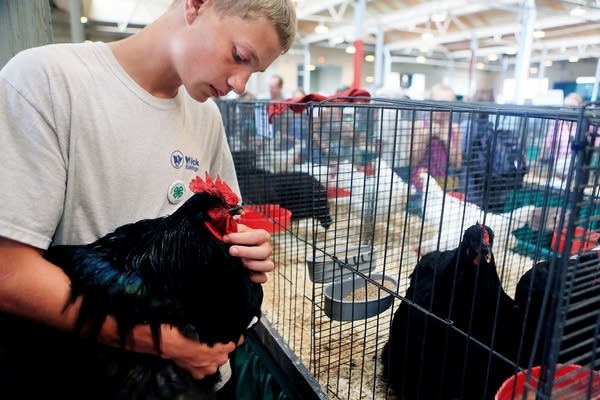Avian flu places State Fair poultry exhibition in doubt

Like this?
Log in to share your opinion with MPR News and add it to your profile.
Like this?
Thanks for liking this story! We have added it to a list of your favorite stories.
The avian flu outbreak that has hit 44 Minnesota turkey farms could lead the Minnesota State Fair to sideline the poultry exhibition this year.
State Fair officials will decide by early to mid-summer whether to cancel the exhibition amid fears that bringing exhibition birds together in one location could further spread the virus. The State Fair opens Aug. 27, following county fairs that get underway in mid-June.
Officials say it's much too early to give up on one of its most popular animal exhibits, but they have been watching the situation closely and consulting with animal health experts since the first case of avian flu appeared in early March.
Fair spokesperson Brienna Schuette said officials have discussed a variety of options, from canceling the poultry program to proceeding as normal. With four months until the fair opens, she said there is no rush to make a decision.
Support the News you Need
Gifts from individuals keep MPR News accessible to all - free of paywalls and barriers.
"We'll do the right thing, of course. We always do here at the fair," Schuette said. "But we just don't know what the right thing is yet."
Last year, exhibitors showed more than 2,100 chickens, turkeys, ducks and geese at the State Fair. The birds typically are considered some of the finest examples of their individual breeds.

Schuette said fair officials want to let exhibitors show their prize poultry, if at all possible. But that desire is tempered by the knowledge that if any of the birds bring avian flu to the fairgrounds, all of the exhibition birds would need to be destroyed.
There's also a risk that a flu outbreak at the fair could spread to many other flocks if the virus hitches a ride on fairgoers' clothing when they head home.
Poultry exhibitors don't want to add to the avian influenza problem and would not fight a decision to close the program, said Bradley Rugg, the state 4-H program director.
"It'd be disappointing for the kids, especially those that have poultry as their project passion," Rugg said. "But you know life is full of disappointments and in a sense it's a good learning experience for those young people who are going through this as well."
The Minnesota Board of Animal Health is still leaving decisions about poultry exhibits up to fair organizers and counties. But Assistant Director Beth Thompson said that approach could change within the next month, if the virus doesn't fade away.
"If it continues down the same path really, or it gets worse, we will have to re-evaluate that," she said.
Thompson said Board of Animal Health officials hope warmer weather will make it much more difficult for the avian flu virus to survive. If that proves true, she thinks the odds are good that county fairs and the State Fair will be able to exhibit poultry this summer.
Although it is rare for a fair or exposition to completely close a poultry barn due to a disease outbreak, it has happened, said Marla Calico, chief operating officer of the International Association of Fairs and Expositions.
The organization has 1,200 members from the United States, Canada, Australia, South Korea and the United Kingdom. Most of those countries have experienced recent outbreaks of avian influenza.
In 2003, Calico attended the Houston Livestock Show and Rodeo during an outbreak of Exotic Newcastle Disease, another deadly poultry virus. She said the Houston organizers couldn't show any birds. But they placed stuffed animals to illustrate the situation affecting poultry producers in Texas at that time.
"They had stuffed chickens in this cage and they had really clever signage explaining to the public that there was a reason for it," Calico said. "So it's not unprecedented."


